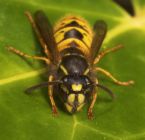HaleakalaAHHHHH! WASSSPS!
From Melissa:
Haleakala National Park is being invaded by Yellowjacket wasps as you are reading this blog.
Invading wasps in Haleakala National Park, which usually make nests the size of a football, have grown nests “the size of a ’57 Buick,” according to a new study.
Research just published in the Proceedings of the National Academy of Sciences shows a fascinating interplay in which the invaders are being shaped by their new environment, just as they are drastically changing the native ecosystem. Not only do the aliens — western yellowjacket wasps, Vespula pensylvanica — take advantage of the lack of cold winters to grow huge nests, they have taken to eating vertebrate meat as well as other insects, geckos and native shearwaters.
Erin Wilson, who has just completed a doctorate in biology at the University of California, San Diego, studied the yellowjackets at Haleakala and Hawaii Volcanoes national parks in 2006 and 2007. The yellowjackets have been a problem in the parks for years, but their new diet and their numbers were a surprise.
In a telephone interview from Acadia National Park in Maine, where she is vacationing, Wilson said yellowjackets like high, lonely places.
They are hard to find, which is why the size of the nests — up to 600,000 individuals compared with a few thousand in a usual nest — escaped attention.
Along with Argentinian ants, the yellowjackets are among the most dangerous alien arthropod invaders of the park.
“It’s not just what they’re killing,” Wilson said. “They’re also collecting great amounts of nectar, drawing down the resources for anything else that might want to feed on it, whether it’s native insects or birds like the Hawaiian honeycreepers.”
The wasps do not attack and kill vertebrates. They scavenge the protein-rich remains of dead animals. But even that could help unbalance the native ecosystem by usurping the food supply for native scavengers, like the pueo.
To read full story, click here






